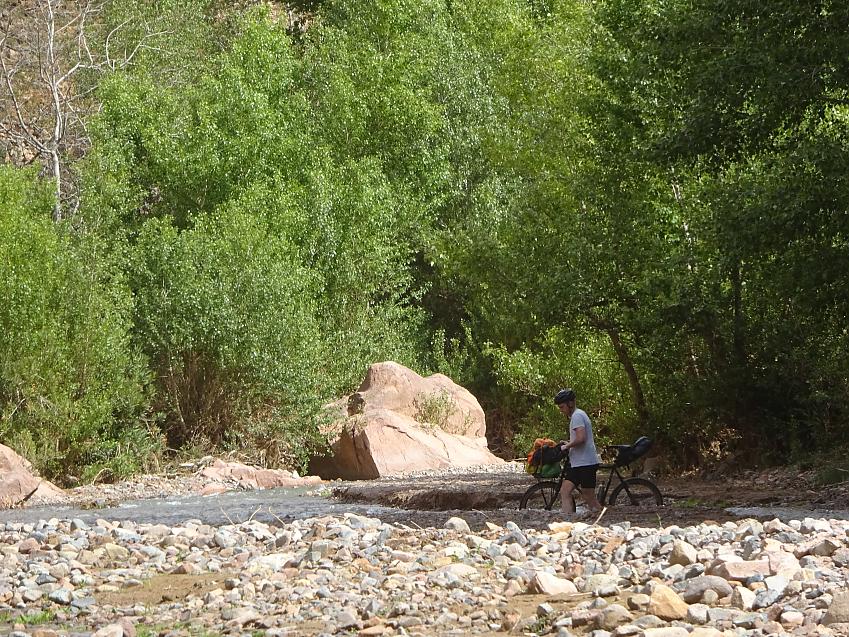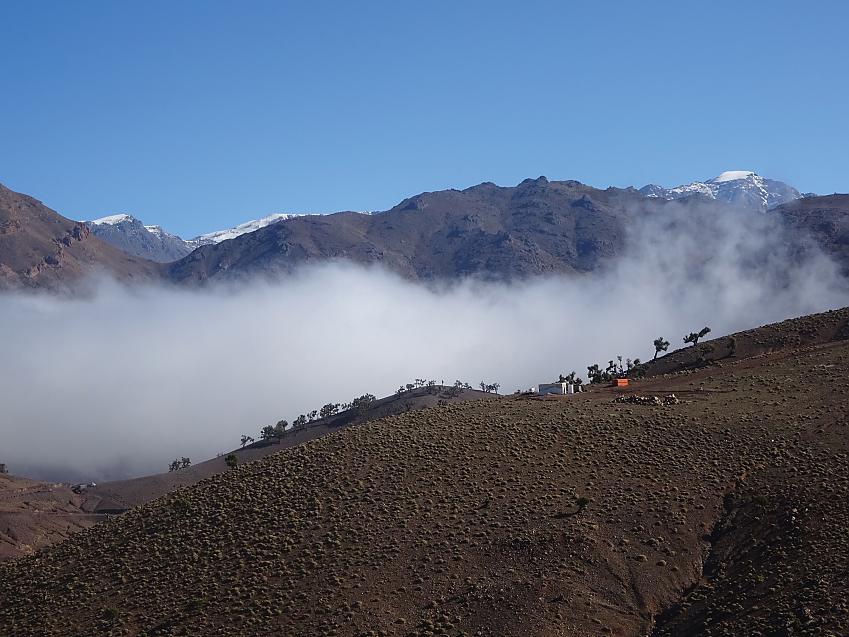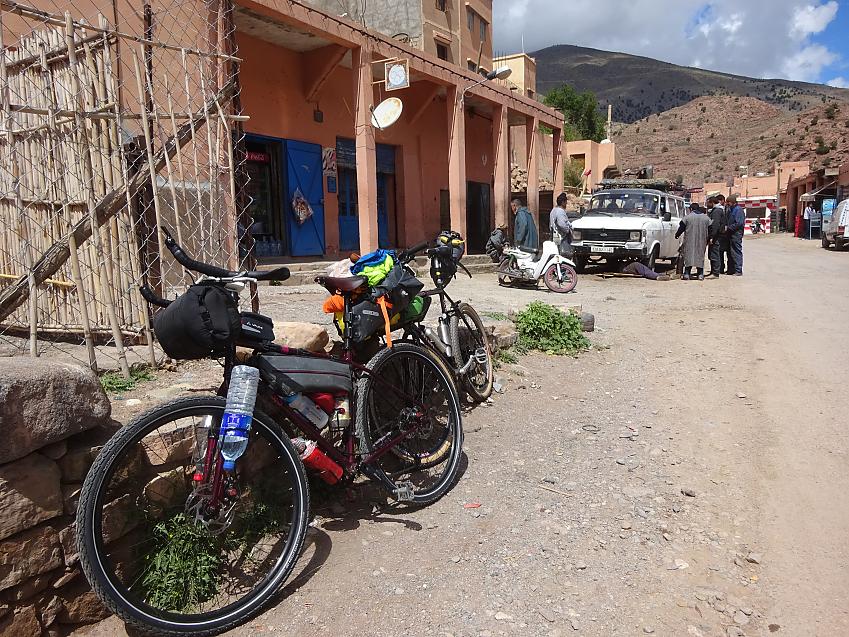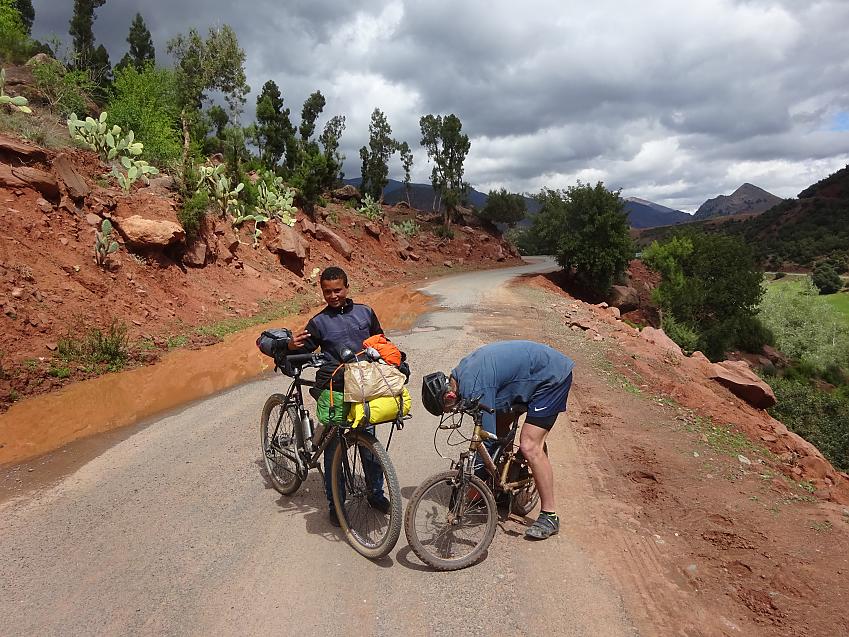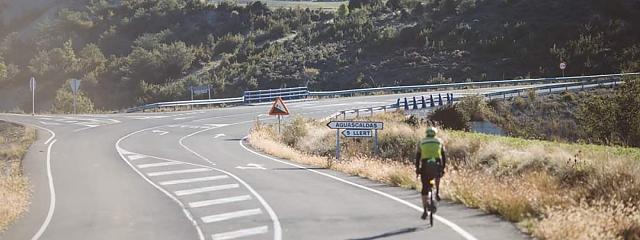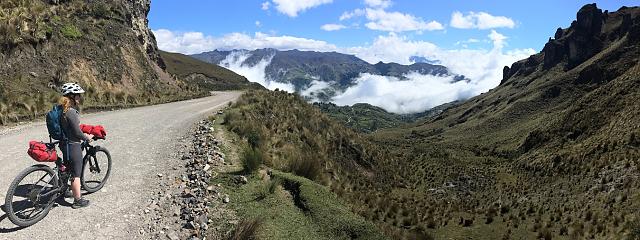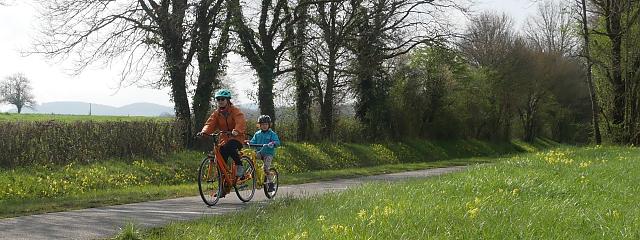
Great Rides: Crossing the Atlas
Great Rides: Crossing the Atlas
Just as I was getting the camp stove fired up for dinner, I heard the shout above the thundering water: “Keir!”
“What?!”
“I’ve dropped the soap in the river!”
Three days into a week-long circuit in the High Atlas Mountains, and with over 5,000m of climbing already under our belts, this was our first chance to freshen up since Marrakesh. Lewis, my companion on this springtime excursion, had had first dibs. With the soap now bobbing down the Asif Tifnout river towards the Sahara, I waved goodbye to a proper wash.
Leafy trees waved in a dry Saharan wind, which swept over the oranges and reds of the arid landscape beyond
Our tent was nestled between steep valley walls and well hidden among lush greenery. The river, buoyed by meltwater from North Africa’s highest peaks and surrounded, like every watercourse in the region, by irrigation channels, had spread life around it. Leafy trees waved in a dry Saharan wind, which swept over the oranges and reds of the arid landscape beyond the river’s touch.
Funky old Medina
We were already settled into the touring life. We’d been welcomed to Marrakesh by Pikala Bikes, a brilliant bike project we’d found on Warm Showers, the online network of cyclists offering places for other cyclists to stay.
Pikala was set up by Dutch national Cantal Baker, who was cycling through the city when inspiration struck. She realised that by being on a bike, with kids joyfully shouting ‘pikala’ (slang for bicycle) as she passed, she’d ceased to be just another tourist and had become part of the city around her. This same transformation from ‘observer’ to ‘participant’ is what makes cycle touring so special, in my view.
Like so many cities, Marrakesh has seen the bike largely muscled out by motor vehicles – primarily coughing mopeds in Morocco. Pikala Bikes is fighting back, promoting cycling by: training local women and men as mechanics and cycle tour guides; recycling old bikes; teaching their homegrown version of Bikeability; and lobbying for investment. Do visit them if you’re nearby.
We unboxed and prepared our bikes in Pikala’s workshop, then were given a glimpse of Marrakesh’s pulsing heart: the medina. On our bikes, we were led through a maze of alleyways, mosques, hammams, and shopfronts, dodging kids playing football, avoiding battered mopeds, and losing all sense of direction. Eventually we reached the shared house where Cantal, her partner, and other Pikala staff and volunteers stay.
A titanic climb
Marrakesh was captivating. Nonetheless we were keen to hit the road, so next morning, less than 24 hours since leaving home, we were riding southwards towards the Atlas Mountains.
We were both buzzing with the unique excitement that accompanies the first morning of a tour. After the planning and prepping, suddenly it’s all real: luggage on the bike, legs spinning, and little idea of what lies ahead. Freedom.
The noises and smells of the city faded quickly. We were among olive groves and cherry blossom, seeing camels at the roadside and foothills rising around us. Taking the road towards the Tizi-nTest pass, we pitched our first wild camp near the small town of Ijoukak. After that, we turned eastwards, left the tarmac behind, and entered the Atlas Mountains proper.
Over the next 30km, a single dirt road led us relentlessly up 1,600m to the pass above. As we climbed through thinning air on the steep, rough road, the world slowly changed around us. Chilly air displaced balmy sunshine. The greenery lining the river below grew distant, giving way to reds, oranges and greys of sandy rock. Trees were replaced by struggling, stunted shrubs.
And it wasn’t just the landscape that changed as we climbed. It felt like we were travelling back in time. Motor vehicles vanished, loaded combi vans replaced by smiling women hauling harvested crops on their backs. Cement buildings in the villages lower down gave way to clusters of adobe houses blending into their surroundings.
Eventually the buildings petered out. We completed the final 500m of climbing undisturbed. Vast cloudscapes lay to our west. Views to the east let us survey the landscape of peaks and valleys we were about to delve into.
Peak touring
We’d entered a dreamworld of cycle touring that words can’t do justice to. Over the next week we’d keep turning corners to find stunning roads stretching out into the distance, winding upwards along valley walls. Snow-capped peaks towered in the background. Red poppies fluttered in the foreground.
While the scenery stunned, the people smiled. Throughout Morocco, but especially in the more isolated stretches of the mountains, we were greeted by friendly faces.
Young men atop passing combi vans; elderly gents on donkeys, faces half hidden beneath woolly hats regardless of the heat; shepherds herding their scraggly goats; all waved and smiled.
Children would swamp the road and practise their French in giggling voices, running alongside the bikes, asking for sweets. They seemed to be enjoying their independence from a young age. We found village stores manned only by eight-yearolds, who would squint at translated words on our phones before a spark of recognition would light their eyes, and they’d run to gather oats, honey, peanuts, or tinned mackerel from the shelves.
We fell into an easy routine: a mid-morning stop for sugary, minty tea; then another couple of hours of cycling before a hearty tajine for lunch – slowcooked meat buried under vegetables, bubbling with spices and accompanied by large flatbreads to soak up the juices. Then we’d ride till evening and find a secluded spot to camp, the setting sun giving way to incredible starscapes.
After four days valley-hopping eastwards, we changed tack and set our sights on Aït Benhaddou, a fortified village on the ancient Sahara-Marrakesh caravan route. It’s been used as a film set for everything from Gladiator to Game of Thrones.
The turn southwards dropped us lower down into a different environment. Touching the edge of the Sahara, we entered genuine desert for the first time. Following a collection of rough 4×4 tracks, we were immersed in desperately dry terrain, horizon to horizon of relentless sun, bouncing back up at us from white sand, without a sliver of shade in sight.
After just half an hour, we were already overheating, lips cracking and eyes squinting. Having crossed less than 10km of this brutal world, we welcomed a return to tarmac and rolled to Aït Benhaddou, in awe of the 4,500km of desert stretching to the Red Sea.
Taxi for Gallagher and Fox-James!
Eventually, after seven dry days and not so much as a puncture, our luck ran out. Crossing the Atlas once again, we found ourselves caught in a hailstorm that set in to heavy rain. Rivers of thick red mud poured onto the tarmac. Drenched, we cautiously descended through a thick mist, eventually reaching an isolated village with the rain still hammering down. Our elation on arrival was short-lived. Lewis’ rear derailleur, bent on the flight over, caught in a spoke and ripped in two.
Soaked and freezing, we were invited indoors for mint tea. The village sheik kindly offered to help us solve our dilemma, but we both knew we had no real option. We threw the bikes on the roof of a taxi and headed for Marrakesh. Next time…
Guide to bikepacking
Interested in touring off the beaten track?
More info
Learn to fix your bike better on a Cycling UK maintenance course.
Do it yourself Getting to Morocco
- The easiest way to get to Morocco is to fly to Marrakesh Menara airport (5km from the city).
- More ambitious travellers can do the journey largely by ferry or train.
- The largely-by-ferry journey is: Portsmouth to Santander or Bilbao (brittanyferries.co.uk – but you can’t book online as a cyclist to Bilbao; you have to phone!); train (or cycle?) to Barcelona; ferry across the Mediterranean to Tangier (gnv.it/en).
- The largely-by-train journey is: Eurostar from London to Paris; TGV to Barcelona (where you could take the above ferry to Tangier); fast train to Algeciras; ferry across the Straits of Gibraltar to Tangier. More details.
- A 120×90cm bike bag will be sufficient for European trains but you’ll need to book the bagged bike on Eurostar – unless it's no bigger than
- 85cm in its largest dimension, in which case it’s luggage. That requires a folder, a separable bike, or Rinko-style packing. More details on suitcase bikes.
Geography: The Atlas Mountains in two minutes
- A range of mountains in northwest Africa that stretches 1,500 miles across Morocco, Algeria and Tunisia.
- Toubkal is the highest mountain in Morocco, reaching 4,165m.
- The High Atlas regionruns diagonally across Morocco for almost 1,000km, encircling Marrakesh.
- The Berber dialect Tashelhit is spoken.
- The landscape varies from season to season: snow in winter and gushing river valleys in spring.
- Wildlife includes Barbary apes, wild boar, and jackals.
Fact file: Crossing the Atlas
- Distance: 450km total. About 50km per day in the mountains.
- Route: South from Marrakesh towards the Tizi-n-Test pass, then east at Ijoukak. At Aït Benhaddou we returned northwards, following the old caravan route to Telout, then over the Tizi n’Tichka pass and ending in Larbaa Ghoujedama.
- Conditions: Mostly sunny on the valley floor but chilly over the passes, with one day of torrential rain. A mix of dirt roads and tarmac.
- Accommodation: Hosted in Marrakesh via Warmshowers, then camping.
- Bikes used: I was on a Genesis Vagabond, Lewis a vintage Trek 830 Mountain Track.
- Maps/guides: Google Earth’s satellite view for route planning. Open Street Maps for on-theground navigation.
- Glad I had: A stove. There’s only so much tajine you can handle.
- Next time I would: Learn some Arabic or French beforehand.
- Further info:






